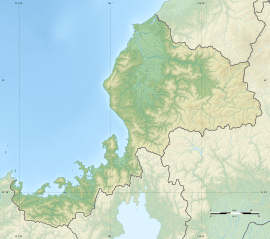Ōzan Kofun Cluster
Ōzan Kofun Cluster (王山古墳群, Ōzan Kofun gun) is group of kofun burial mounds located in what is now the Hinode area of the city of Sabae, Fukui in the Hokuriku region of Japan. The site was designated a National Historic Site of Japan in 1967.[1]
王山古墳群 | |
Ōzan Kofun Cluster | |
 Ōzan Kofun  Ōzan Kofun Cluster (Japan) | |
| Location | Sabae, Fukui, Japan |
|---|---|
| Region | Hokuriku region |
| Coordinates | 35°56′23.0″N 136°11′5.6″E |
| Type | kofun |
| History | |
| Founded | 3rd to 4th century AD |
| Periods | Kofun |
| Site notes | |
| Ownership | National Historic Site |
| Public access | Yes |
Overview
The kofun cluster is located on an isolated hill near the centre of the modern city of Sabae, and consists of 49 tumuli dating to the late Yayoi period through the early Kofun period. the area was originally designated a protected area in 1942; however, after a detailed survey was conducted in 1967, it was determined that the area under protection did not include all of the site, whereas conversely a large portion of the protected area was not necessary. The borders of the area were revised and the new boundaries became a National Historic Site in 1967, and form part of a city park with walking trails.
A total of eleven tumuli were excavated in 1965 (No. 1-7, 9, 25, 31 and 32), of which No. 1, 3, 4, and 7 were square mounds, 8 to 12 meters on a side with a height of 1-2 meters, and were dated to the late Yayoi period. All of the tombs had the remnants of a wooden sarcophagus, with the exception of No.4, which had two. All of the tombs had grave goods, mostly pottery fragments, with the exception of No.1, which was completely bare. Tomb 3 had goods from the Tōkai region and Kansai region of Japan, indicating long-distance trade even in ancient times.
Tombs No. 5, 7, 9 and 25 were also square tombs, 8 to 14 meters on a side, but were dated from the early Kofun period, as indicated by the presence of fragments of swords and other weapons, and metal horse fittings found inside. Tomb No. 31 was a round tomb with diameter of 20 meters and height of 2 meters, and Tomb No. 32 was also a round tomb, but with diameter of 8 meters. Both were also dated to the early Kofun period, and contained many artefacts.
The tomb does not appear in any historical records and the name of rank of the person buried within is unknown. It is one of many similar kofun which have been discovered in the area, which has been densely populated since the Yayoi and Kofun periods, and from its scale it must have been the tomb of a local chieftain or other person of importance.
References
- "王山古墳群 おうざんこふんぐん" [Ōzan Kofun Cluster] (in Japanese). Agency for Cultural Affairs.
External links
| Wikimedia Commons has media related to Ozan Kofun Group. |
- Sabae city home page (in Japanese)
- Fukui Prefectural home page (in Japanese)